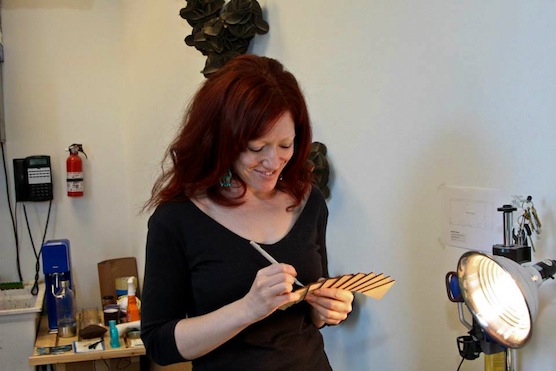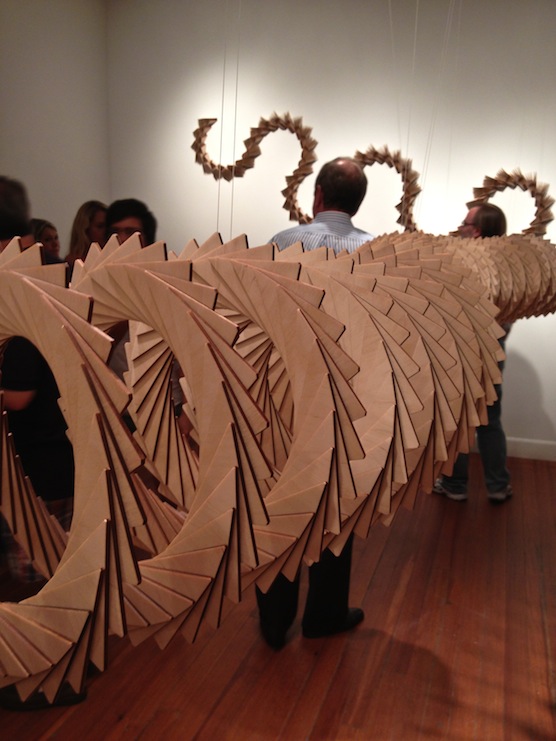
This month, Ashley Powell, HCCC Curatorial Assistant, and Kathryn Hall, HCCC Curatorial Fellow, interviewed current resident artist, Susannah Mira, who finishes her residency at HCCC this week.
Ashley Powell: For the readers who may not be familiar with your work, can you explain to us a little bit about what you make and your process?
Before coming to Houston Center for Contemporary Craft and during my residency here, I’ve worked with discarded materials and, in particular, discarded manufactured items, or those things that end up in the manufacturing waste stream. As a result, the materials I work with vary; so, while I’ve been working with wood here at HCCC, plywood in particular, other projects have been made of cork, rubber, foam, paper, and all sorts of plastic derivatives. After acquiring a new batch of material, my working process is, I would say, one of trial and error. In the beginning phases, I spend time figuring out the methods and materials to connect the pieces to create sculptures. I’m most interested in creating pieces that have an organic feel to them, despite the fact that they are coming from processed or human-made materials.


Kathryn Hall: One thing I’m curious about is with using these materials, do you feel like enterprise and the distribution of labor play into your work? Do you feel these industrial materials reflect something greater?
In the media, we’re told that the types industries that are producing the materials I’m working with are dramatically contracting, if not an altogether mythic part of our history. So, sometimes, I do consider that I’m utilizing relics. I’ve also thought quite a bit about how the demise of domestic manufacturing signals a changing economy, one that favors different kinds of labor and, thereby, alters the composition of the workforce in terms of gender, in particular.
KH: But do you feel like the statement you are making is affecting a broader audience? Or that it’s doing more than just repurposing these materials you have in front of you, maybe creating an opportunity for something further to happen?
[Laughing] I would love to think so. Throughout the residency, I’ve had visitors come into my studio, all in a positive way, telling me that I’m doing something good and saying, “Oh, wow! You’re taking these materials that would have been thrown away and putting them to good use!” Lately, I’ve been wondering, “Am I?” I’ve spent a year working with scrap from one, small manufacturing run. I may have salvaged several thousand plywood triangles, but the time involved in transforming them into a few sculptures is immense. Considering resource use in those terms reveals just how much stamina it takes to avoid the landfill.
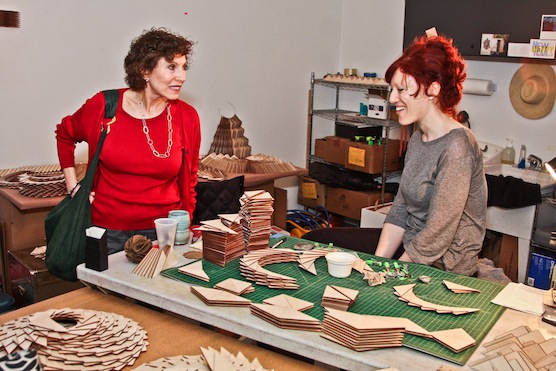
KH: I know you have a solo exhibition, Room Divider, at Lawndale Art Center that opens this month. Could you tell us a little more about this exhibition and the concept behind it?
The pieces I have been building up incrementally will come together in a way and in a scale that has not been possible in my studio. For example, I’ve been making these short coils that I’ll connect to create a twenty-one-foot-long piece. Though I’ve been making all of the parts, together, it will be a new way to see the work. It will definitely be rewarding to see everything finally assembled and in a different space.

AP: I know you have been awarded several residencies. What were some of your most memorable residency experiences?
I’ve done 17 residencies. They’ve all been different, but the similarity has been the award of time and space to create—and in the best cases, a family, even if a temporary one. For example, the first residency I did was in a hotel in New York City, called the Gershwin Hotel (though it’s since been sold). And the next was in a former thrift and surplus store in Greensboro, North Carolina, called Elsewhere. That’s going back to 2008. I’d say my heart really rests in southern New Mexico, where I was a resident at the Border Art Residency. There, I was the only artist living and working in a renovated cotton gin for 10 months. HCCC is actually the first residency I’ve done that didn’t incorporate a housing component. So this is the closest one to, dare I say, real life, than other residency experiences, which can be a lot more immersive, especially if you’re in a rural area or on a campus. Being in a city and having a life separate from the Center makes it different, for sure.
AP: Has traveling so extensively influenced your work and your practice in a particular way, changed it somehow or allowed you to experiment?
I think the frame of mind you nurture when you are living itinerantly definitely affects the work and, in particular, for me, choosing to engage waste materials certainly grew out of the experience. I’m using discarded stuff out of environmental concerns—with an interest in utilizing materials specific to a certain place or region—and also for economic reasons. Not having to buy the majority of the material has made it easier, when it’s been impossible to take projects with me to the next residency.
AP: Where do you see yourself going in the future with your practice?
My main goal, and I think about it a lot, is to sustain art making over a lifetime. There are so many ways to approach that. I’m staying in Houston after the residency, and I’ll be moving my studio into my home, at least for now. By necessity, that will change how I work and the scale of what I’m doing, again, at least temporarily. One thing I’d love to explore is working with companies to build commissions from the discarded materials or products of their commerce.
KH: What is the longest amount of time you’ve spent on a single work?
I would say it’s the past year, working with the sum of plywood I have. Though it’s not a single piece, I’ve worked steadily with this plywood for much longer than any other material.
AP: I know you might not keep track of this, but what is the largest amount of individual pieces you’ve used in a work or body of work?
I do like keeping count! Some of the plywood sculptures I’m making now encompass 2,000-3,000 single pieces. I also created a sculpture in 2010 with garment hangtags, called Paper Trail, which incorporated 150,000 paper labels. Though, to be clear, I was able to grab and place big chunks at a time—that is to say, I wasn’t handling each and every label on its own.
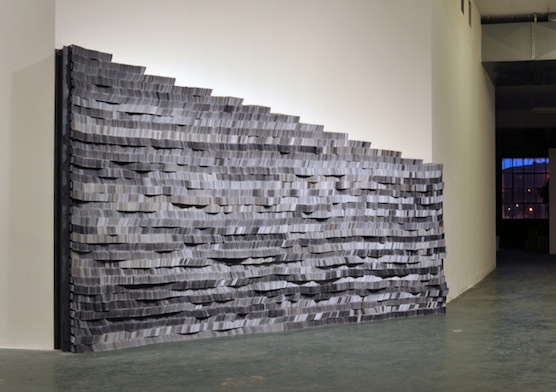
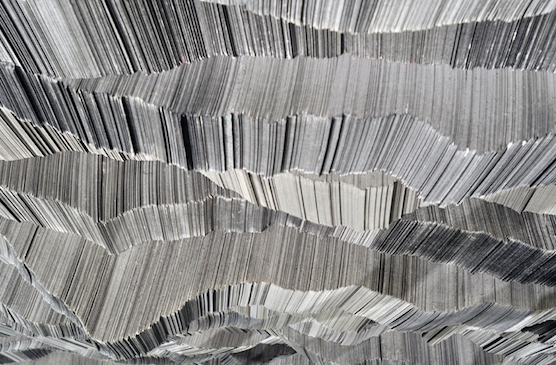
KH: What has been the highlight of your HCCC residency?
I came into the residency really interested in staying in Houston and, happily, I’ve found that the kind of interaction both with the HCCC community and with the public has been a really friendly and positive one. It has definitely helped me transition from being on the road as a lifestyle to creating a permanent home. Having a longer residency and feeling integrated into a larger network of people has been the most rewarding thing above and beyond the obvious, which has been working in the studio every day.
